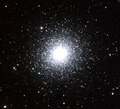File:M2, NGC 7089 (noao-m2).jpg
From Wikimedia Commons, the free media repository
Jump to navigation
Jump to search

Size of this preview: 658 × 599 pixels. Other resolutions: 264 × 240 pixels | 527 × 480 pixels | 843 × 768 pixels | 1,124 × 1,024 pixels | 1,500 × 1,366 pixels.
Original file (1,500 × 1,366 pixels, file size: 615 KB, MIME type: image/jpeg)
File information
Structured data
Captions
Captions
M2 is a globular cluster in the constellation of Aquarius.
Summary
[edit]| DescriptionM2, NGC 7089 (noao-m2).jpg |
English: M2 is a globular cluster in the constellation of Aquarius. Its actual position in the galactic halo places it in the southern galactic cap, almost directly beneath the southern pole of our Galaxy, the Milky Way, and at a distance from us of around 47000 light-years. M2 is a compact and fairly dense globular cluster. In fact, it is one of the richer globulars, containing more than 100,000 stars (of which only about 5000 are visible here), and stretching more than 150 light-years across. The brightest stars that can be seen within it are mostly red and yellow giants of absolute magnitude about -3. Overall, the absolute magnitude is -9, but the apparent magnitude (as seen from Earth) is 6.3. This makes it a good candidate for viewing with binoculars and small telescopes. Like other globular clusters, which are the oldest, densest, and most populous star clusters in the Milky Way, M2 is made up of stars that are all the same age. These are amongst the oldest stars in our Galaxy, at an age of about 13 billion years. Because the stars in a globular cluster are all the same age and all at the same distance from Earth, they provide an excellent laboratory in which astronomers can study stellar evolution. The stars of a globular cluster can also be used to understand "standard candles", which is to say, types of stars that all have the same intrinsic brightness, and can therefore be used to measure distances. Although M2 does contain RR-Lyrae variables, one such type, there are fewer of them in M2 than in most other globular clusters. M2 also contains Cepheid variables, but since they are population II Cepheids and not the usual population I type, they cannot be used as standard candles. This picture was created from six images taken in July 1997 at the KPNO 0.9-meter telescope during the summer Research Experiences for Undergraduates (REU) program operated at the Kitt Peak National Observatory and supported by the National Science Foundation. Image size 17.0x15.5 arc minutes. |
| Date | 30 June 2020, 21:34:00 (upload date) |
| Source | M2, NGC 7089 |
| Author | Doug Williams, REU Program/NOIRLab/NSF/AURA |
| Other versions |
|
Licensing
[edit]This media was created by the National Optical-Infrared Astronomy Research Laboratory (NOIRLab).
Their website states: "Unless specifically noted, the images, videos, and music distributed on the public NOIRLab website, along with the texts of press releases, announcements, images of the week and captions; are licensed under a Creative Commons Attribution 4.0 International License, and may on a non-exclusive basis be reproduced without fee provided the credit is clear and visible." To the uploader: You must provide a link (URL) to the original file and the authorship information if available. | |
This file is licensed under the Creative Commons Attribution 4.0 International license.
| |
File history
Click on a date/time to view the file as it appeared at that time.
| Date/Time | Thumbnail | Dimensions | User | Comment | |
|---|---|---|---|---|---|
| current | 18:19, 17 September 2023 |  | 1,500 × 1,366 (615 KB) | OptimusPrimeBot (talk | contribs) | #Spacemedia - Upload of https://noirlab.edu/public/media/archives/images/large/noao-m2.jpg via Commons:Spacemedia |
You cannot overwrite this file.
File usage on Commons
The following page uses this file:
Metadata
This file contains additional information such as Exif metadata which may have been added by the digital camera, scanner, or software program used to create or digitize it. If the file has been modified from its original state, some details such as the timestamp may not fully reflect those of the original file. The timestamp is only as accurate as the clock in the camera, and it may be completely wrong.
| Image title |
|
|---|---|
| Credit/Provider | Doug Williams, REU Program/NOIRLAB/NSF/AURA |
| Short title |
|
| Date and time of data generation | 21:34, 30 June 2020 |
| Keywords |
|
| Contact information |
None None, None, None None |
| IIM version | 4 |

